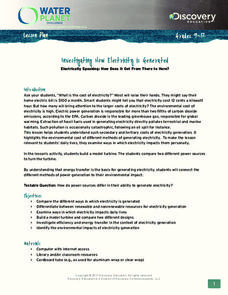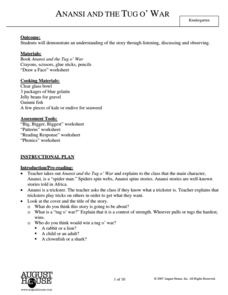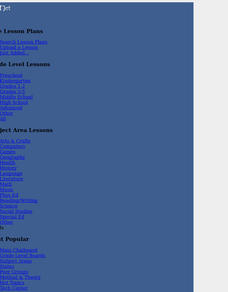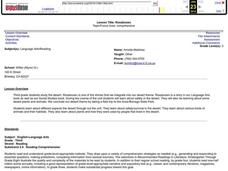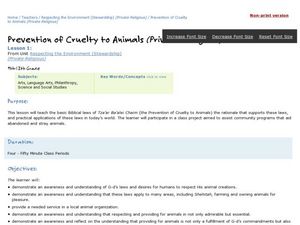Curated OER
EEEK! A Spider!
Youngsters complete a unit of lessons based on the story "Little Miss Muffet." They predict what will happen in the story, and use context clues to look for meaning in the words. They research information about spiders using the Internet...
EarthEcho International
Investigating How Electricity is Generated
What is the real cost of electricity? The real cost is not just the price you pay, but the environmental and economic costs as well. Scholars build, use, and judge the effectiveness of a turbine. They also investigate the...
August House
Anansi and the Tug o' War
Combine art, math, language arts, drama, and delicious Jell-o with a instructional activity based on the African folktale Anansi and the Tug o' War. Kids make predictions and discuss plot points of the story before joining in...
Curated OER
Habits: An Introduction
Second graders identify different types of habitats animals live in to have a better understanding of the world around them. They choose a habitat, draw a picture of an animal that lives there and list the unique attributes the habitat...
Curated OER
Zoo Animal Facts
Students create a fact sheet naming an animal's habitat, distinguishing characteristics, eating type, country of origin, and any interesting information that they research. They illustrate their fact sheet and sheets are compiled into a...
Curated OER
Roxaboxen
Third graders discuss the story "Roxaboxen." For this reading comprehension lesson, 3rd graders discover new vocabulary words, discuss the story using story mapping, and take a reading test. Students investigate safety in the desert and...
Curated OER
Sociology: What is life like for Gulf Coast rice farmers
Students read 1 page about Gulf Coast rice farmers and then describe what rice farming in the U.S. is like in the United States. In this rice farming lesson plan, students tell why they would or would not want to be a rice farmer.
Alabama Learning Exchange
Once Upon A Bear
Students study the characteristics and habitats of a variety of bears in this series of cross-curricular lessons.
Columbus City Schools
Get Your Organisms Organized
From large to small, show your class how to organize them all! Included within the guide is everything you need to take their knowledge of classification from the cellular to the species level. The worksheets focus on...
Indian Land Tenure Foundation
Respect for Land
Youngsters examine how people show respect and care for the land. Specifically, learners see how the Native Americans truly did care for and respect the land, and still do so to this day! They also explore how they themselves can care...
Marine Institute
Water Pollution
Sixth graders investigate the various types of pollutants found in water and ways to help prevent water pollution. Through a hands-on experiment, students create samples of polluted water by mixing water with vegetable oil, dirt,...
Forest Foundation
Fire - How Does it Relate to You?
Forest fires can be a necessary step in keeping a forest healthy, but what happens when they get out of control? Learners investigate the causes and effects of forest fires in two specific areas, culminating in a report about the ways...
Alabama Learning Exchange
Zoo Animals
Students identify different types of animals and their habitats. They compare natural habitats to habitats. They use Internet resources to gather information on animals.
Curated OER
My Happy Habitat
Students observe and discuss the Idaho state quarter to begin an activity in which they define and draw different types of habitats. They discuss the habitats that the migrating Peregrine falcon, which appears on the Idaho quarter,...
Curated OER
Students Solutions - Saving Our Surroundings
Young scholars explore the environmental impact of humans on the plants and animals in their state. In this environmental impact lesson, students use digital cameras to photograph plants and animals in their state. Young scholars...
Curated OER
Biosphere
Students examine the basic biosphere and its components. In this ecology activity students complete several experiments including designing a system that is balanced to sustain life.
Curated OER
Food Chain
Learners explore the cycle of how each living thing gets food. In this food chain unit, students participate in four lesson plans that highlight animal vocabulary, habitats, and the role of humans in our ecosystem. Learners demonstrate...
Curated OER
Cycles of Life in an Urban Habitat: Changes in Biodiversity
Second graders compare and contrast animate and inanimate objects. In this environmental science activity, 2nd graders create simple food webs. They observe their environment and create a collage about it.
Curated OER
Connecticut Wildlife: Biodiversity and Conservation Status of Our Vertebrate Populations
Students explore the different types of vertebrates found in their area. For this environmental science lesson, students perform a case study on the Common Raven. They analyze data collected from research and create charts and graphs.
Curated OER
Life Giving Rivers
Students examine the world's rivers in this six lessons unit which mingles science with social studies. The dynamic forces that create erosion in nature are also seen as habitats and ecosystems that are affected by environmental and man...
Curated OER
Prevention of Cruelty to Animals (Private-Religious)
Students examine how to prevent cruelty to animals. In this stewardship lesson, students discover the Biblical laws of Tza’ar Ba’alei Chaim. Students volunteer their time to assist community organizations that promote animal welfare.
Curated OER
Marine Animal Tracking
Learners engage in a instructional activity which serves as an introduction to the ideas and implications of animal tracking. They monitor animal foraging behavior on a spatial scale. The students break into groups and track each other's...
Curated OER
Sharks: Fact or Fiction
Second graders discover the truth about sharks. For this shark lesson, 2nd graders use different resources to help distinguish between fact and fiction with what they have heard about sharks. They complete an attached activity sheet.
Curated OER
It's Goin' Down; The Rain Forest
Students discover the global problem of deforestation. In this environmental instructional activity, students identify organizations on the quest to stop deforestation. Students also discover what they can do to solve this global dilemma.



